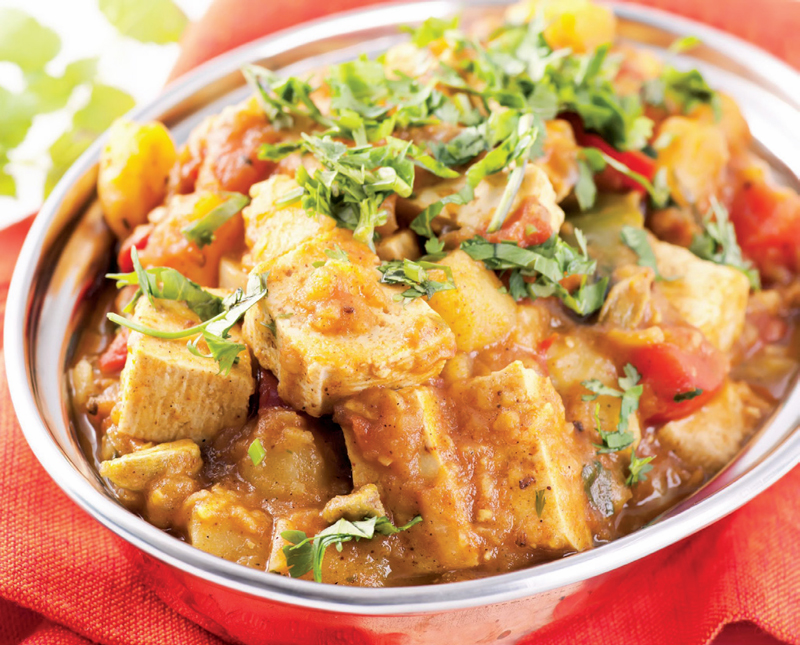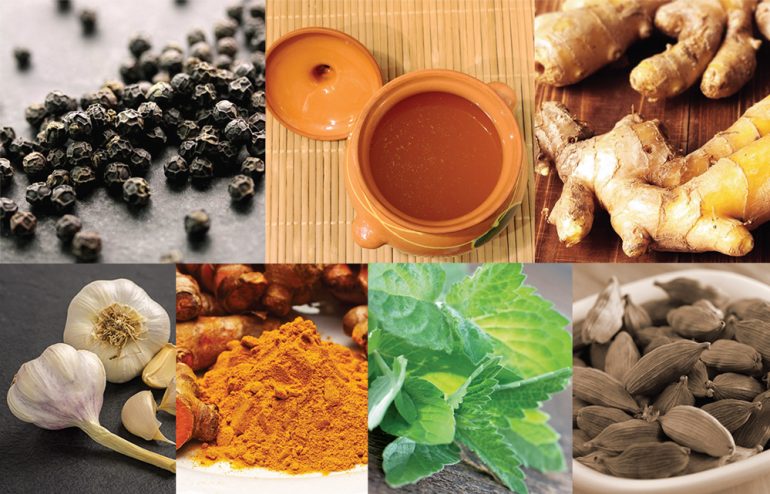Ayurveda is the art of living in harmony with nature and diet is one of the most important tools for achieving and maintaining healthy balance. Ancient Ayurveda invented a simple system to create healthy meals with all of the necessary nutrients, which are defined as the ‘six tastes,’ sweet, sour, salty, bitter, pungent and astringent.
Ghee
Ghee is clarified butter, and the preferred oil to cook with in Ayurveda. Ghee acts as a carrier to help herbs and spices assimilate into the body more easily and to go where they need to go. You can buy ghee in most health food stores, and you can also make your own ghee at home.
To make ghee, put one pound of unsalted butter into a saucepan and heat slowly until completely melted. Turn the heat down to low. The melted butter appears cloudy, and initially, white foam rises to the top. The foam then falls to the bottom as the melted butter starts to clear, and the sediment is more visible at the bottom. Simmer until the sediment becomes golden brown and the rest of the liquid becomes clear and golden. At this point it kind of smells like popcorn!
Remove from heat and cool for 10 minutes. Line a strainer with cheesecloth or muslin and place over a glass jar. Pour the ghee through the strainer, taking care not to pour in any of the sediment. As the ghee cools, it will solidify. It does not need to be refrigerated.
Garlic
Whenever someone I know gets a cold, I advise him or her to “eat garlic!” Garlic has powerful anti-viral properties. Ayurveda has known this for centuries. One of the reasons garlic is so healing is that it contains five of the six Ayurvedic tastes and is also balancing for all three of the mind-body types called doshas: Vata, Pitta and Kapha.
Many people who use garlic on a regular basis claim that they have immunity from cold and flu viruses. There are garlic capsules available and while you can avoid the odor associated with this root, there is no substitute for the real thing. Garlic stimulates digestion and helps with overall rejuvenation. Fresh is best! Garlic can be added to sauces and salads and roasted garlic is mild and makes a delicious spread. There are clay pot garlic roasters made specifically for this purpose.
 Ginger
Ginger
Ginger is used often in Ayurvedic cooking. It can be used in so many ways, both fresh and dried. Fresh ginger is balancing for both Vata and Pitta doshas. Dried ginger is stronger and more concentrated and thus is balancing for Kapha. Ginger kindles the digestive fire called “agni,” stimulates the appetite, and also helps the body to digest, absorb and assimilate food.
Ginger has a warming property, so it is especially helpful in the cold winter months. Ginger is very difficult to eat raw (not recommended) because of its potent pungency, however this root is a tasty addition to sauces or stir-fry. Ginger is delicious in baked goods and dessert, like gingerbread or ginger snap cookies. Ayurveda recommends ginger as a treatment for joint pain and to prevent or relieve all kinds of motion sickness. It is also wonderful to help alleviate coughs, congestion and runny noses. The right kind of food in balance is most definitely good medicine.
Turmeric
Turmeric is one of the oldest, most important spices in Ayurvedic cooking. It is the spice that gives curry its yellow color. Turmeric is bitter, astringent and pungent in taste, and has a heating quality. Due to its heating quality, turmeric helps to balance Kapha and Vata doshas and because it also has a bitter taste, it helps to balance the Pitta dosha, thus making it tridoshic.
Turmeric is also beneficial for helping with occasional congestion, and soothing a hoarse voice or the occasional cough. Curry is actually a blend of herbs that is abundant in Indian cooking. If you’re interested in making your own curry blend, experiment to see how spicy you like it. Red pepper, black pepper, mustard seed and chili flakes are optional. I like a very mild curry, so this is a combination that works for me. Mix together:
½ teaspoon ground ginger
1 teaspoon ground cumin
1 teaspoon ground coriander
2 teaspoons ground turmeric
Cumin
Cumin is popular in Indian, Mexican and Middle Eastern cuisines. According to Ayurveda, it is balancing for all three doshas. It has been known to aid digestion and helps flush toxins out of the body.
Cumin can be used either as whole seeds or ground, raw or dry-roasted. Ground raw, it is a dull brown color, which is enriched by being sautéed in ghee or oil. Powdered dryroasted cumin is a rich brown in color. Both sautéing and roasting make the aroma and flavor of cumin come alive. Cumin combines well with a wide range of other spices, including turmeric, fennel, coriander, ginger and cinnamon. Cumin is especially delicious in dal and soups.
Coriander
Coriander is a tridoshic spice much revered in Ayurveda. It is a cooling spice and contributes to the sweet and astringent tastes. Ayurvedic texts suggest that it is good for digestion, whets the appetite, helps combat allergies, and also helps purify the blood. Coriander by itself has a sharp aroma and smells and tastes best freshly ground in a coffee or spice mill. Ground coriander can be added along with other spices to dal and vegetables as you cook.
Fennel
At Indian restaurants you may see fennel seeds instead of after-dinner mints. This is because fennel is extremely good for digestion. It acts as a general toner for the digestive system, and is particularly good for enhancing agni, the digestive fire, without aggravating Pitta. In India, eating a few toasted fennel seeds after a meal is a common practice, and it is also used to freshen the breath. Fennel has a distinctive smell rather like aniseed, or licorice. It has a nutty flavor and a strong aroma when sautéed in ghee. Fennel is considered a cooling spice, and it has the taste of both sweet and bitter.
Basil
Sweet Basil is used in cooking in both its fresh and dried forms. Basil is balancing for Vata and Kapha, and for Pitta when used in lesser quantities. It is a warming herb, and contributes the sweet, bitter and pungent tastes. Basil is easy to grow outdoors in the summer months, and I love to have some on hand right in my backyard for whenever I want to make bruschetta or add some fresh basil to sauces or salads.
Basil can also be made into a tea, and this is often used in Ayurveda to maintain and promote the long-term health of the respiratory tract. It is also used to settle stomach disorders and to enhance digestion. A mild natural sleep aid, basil enhances the quality of sleep. Dried basil is aromatic and is wonderful to flavor soups and stews. It is stronger in flavor when dried, so you don’t need very much of it.
Cinnamon
Cinnamon is the peeled bark of an evergreen tree. There are many different types of cinnamon found throughout the world. The kind we find most often in the U.S. is from the cassia tree, and is harvested in Vietnam, Indonesia and China. The characteristic spicy flavor of cinnamon comes from its essential oils. These oils give cinnamon its healthful benefits, too. Cinnamon tea can freshen breath, and relieve an upset stomach. The fragrance of cinnamon can scent an entire room! I like to boil cinnamon sticks right on the kitchen stove to get that warm, homey feeling.
Cinnamon is a warming spice, and it consists of sweet, pungent and bitter tastes. It is excellent for pacifying Kapha and good for balancing Vata also. In Ayurveda, cinnamon is used to assist digestion and to calm stomach disorders. Studies have shown that just half a teaspoon of cinnamon a day could reduce total cholesterol by 12 to 30 percent, while it also boosts the body’s ability to store blood sugar. You can add a sprinkle of cinnamon to your morning oatmeal, on your toast, or in your hot cocoa. You can also sprinkle some cinnamon in chili, or on sweet potatoes, or add it to baked goods.
Black Pepper
Black pepper is widely used as a seasoning in the Western world. In Ayurvedic cooking, black pepper in all its forms: peppercorns, cracked pepper and ground black pepper, is used as well. Pepper has cleansing and antioxidant properties, and it is a bioavailability enhancer, meaning that it helps to transport the benefits of other herbs to the different parts of the body. Pepper also helps the free flow of oxygen to the brain; helps enhance digestion and circulation; stimulates the appetite; helps maintain the respiratory system and the health of the joints.
Black pepper is a warming spice and has a pungent taste. It is terrific for pacifying Kapha, and just a little bit helps pacify Vata. Black pepper should be used in moderation as it does increase Pitta.
Mint
Mint is a hearty plant and easy to grow. I’ve got an abundance of two different kinds in my front yard. There are many varieties of mint, including the popular Spearmint and Peppermint. Mint is a cooling herb, with a sweet taste and a pungent aftertaste.
Most varieties of mint are pacifying for all three doshas, and since it is cooling, mint is especially helpful for balancing Pitta. Mint is good for digestion as well as for the respiratory system health. You can make a tea out of dried mint for a refreshing summer beverage. Mint is also delicious when added to chutney.

Cardamom
Cardamom is often used in desserts in India and the Middle East. It is considered a warming spice, and it has both sweet and pungent tastes. Cardamom is considered tridoshic, balancing to all three doshas – however Pittas need to use smaller amounts of any pungent spice. Cardamom is really good for digestion. It can help reduce bloating and gas.
You can chew up cardamom seeds to freshen the breath, and to ease a sore throat. This is a really good tip that I got from Dr. Vasant Lad, one of the world-renowned authorities on Ayurveda. He offered me some cardamom seeds on a break during one of his lectures. Delicious!
Churnas
According to Ayurveda, a balanced diet contains all six tastes at every meal. This can be challenging given our Western influences. And since we want to make sure that we are getting the right proportion of flavors for our own dominant dosha, we tend not to want to overdo it. There’s a simple solution! An herb and spice blend especially formulated for Vata, Pitta or Kapha balancing. You can use this blend while cooking, or take the shaker with you to sprinkle on your food when you eat out. You can add it to sauces, soups, vegetables, or rice dishes, even just sprinkle it on salads, popcorn, or snacks. You can make your own at home in the kitchen, or purchase one already made.
The Vata blend is calming, and includes cardamom, ginger, and other spices. The Pitta blend is cooling, and includes cumin, coriander, fennel, and other spices. The Kapha blend is invigorating, with turmeric, mustard, black pepper and more.
Vata Churna
Ingredients
2 tablespoons cumin seeds
2 tablespoons coriander seeds
½ teaspoon cardamom seeds
2 tablespoons fennel seeds
1 teaspoon ground ginger
¼ teaspoon asafetida (hing powder)
¼ teaspoon salt (I prefer Himalayan salt, it is unprocessed)
1 tablespoon raw sugar
Directions
- In a dry skillet, roast the cumin and coriander seeds until nutty.
- Transfer to a spice grinder and add cardamom and fennel seeds; process to a fine powder.
- Put the ground spices in a bowl with the ground ginger, asafetida and salt and mix all together.
- Transfer into a shaker bottle to use.
Pitta Churna
Ingredients
2 tablespoons fennel seeds
2 tablespoons coriander seeds
2 tablespoons cumin seeds
1 tablespoon ground turmeric
2 tablespoons dried mint leaves
½ teaspoon ground ginger
1 tablespoon raw sugar
Directions
- In a dry skillet, roast the coriander and cumin seeds until nutty.
- Transfer to a spice grinder and add cardamom and fennel seeds; process to a fine powder.
- Put the ground spices in a bowl with the turmeric, mint leaves, ground ginger and sugar and mix all together.
- Transfer into a shaker bottle to use.

Kapha Churna
Ingredients
2 tablespoons coriander seeds
1 tablespoon cumin seeds
1 tablespoon fenugreek seeds
1 tablespoon ground ginger
1 tablespoon ground turmeric
1 tablespoon ground cinnamon
1 teaspoon ground cloves
½ teaspoon ground black pepper
Directions
- In a dry skillet, roast the coriander and cumin seeds until nutty.
- Transfer to a spice grinder and add fenugreek seeds; process to a fine powder.
- Put the spices in a bowl with the ginger, turmeric, cinnamon, cloves and black pepper and mix all together.
- Transfer into a shaker bottle to use.
 Lissa Coffey is a lifestyle and relationship expert who serves up an inspiring blend of ancient wisdom and modern style. She appears frequently on television and radio, and contributes to national publications with her insightful and compassionate approach to modern-day issues. Coffey is also a bestselling author and has written books like “Song Divine: A New Lyrical Rendition of the Bhagavad Gita.” WhatsYourDosha.com.
Lissa Coffey is a lifestyle and relationship expert who serves up an inspiring blend of ancient wisdom and modern style. She appears frequently on television and radio, and contributes to national publications with her insightful and compassionate approach to modern-day issues. Coffey is also a bestselling author and has written books like “Song Divine: A New Lyrical Rendition of the Bhagavad Gita.” WhatsYourDosha.com.







